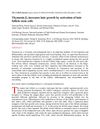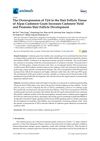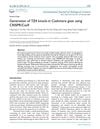Thymosin Beta 4
aka - sh-Oligopeptide-4
- Tβ4
- Thymosin β4
Thymosin Beta 4 is a naturally occurring, highly conserved 43-amino acid polypeptide found in virtually all human tissues and cell types. It functions as a pivotal mediator in a wide array of fundamental biological processes, including cell migration, differentiation, angiogenesis (the formation of new blood vessels), and wound healing. Tβ4 is recognized as a key regenerative peptide, playing a critical role in tissue repair and protection following injury. Research has identified specific functional domains within the peptide; for instance, the active fragment encoded by amino acids 17–23 has been shown to be particularly responsible for triggering angiogenesis and the growth of hair follicles. Its potent, multifunctional nature makes it a molecule of significant interest for therapeutic and regenerative applications.
Sh-Oligopeptide
Sh-Oligopeptide-4 is the cosmetic industry's technological answer to harnessing the power of Tβ4. It is formally defined as a single-chain recombinant human peptide, for which the starting gene is a synthesized copy of the human gene that codes for Thymosin Beta 4. The "sh-" prefix in its International Nomenclature of Cosmetic Ingredients (INCI) name stands for "synthetic human". This designation is significant, as it clarifies that the peptide is not extracted from human or animal sources but is bioengineered using recombinant DNA technology. This process provides a stable, pure, and ethically sourced biomimetic of the natural Tβ4 molecule, effectively translating the biological activity of an endogenous peptide into a viable cosmetic ingredient.
In regulatory and formulation contexts, Sh-Oligopeptide-4 is listed in the European Union's cosmetic ingredient database (CosIng) with the primary function of "skin conditioning". This broad classification underscores its role in improving the overall health and state of the skin, including the scalp. It is important to distinguish Sh-Oligopeptide-4 from another ingredient named "Oligopeptide-4." The latter is a different, much larger synthetic peptide composed of 91 amino acids and is also listed as a skin conditioning agent, but it is not a biomimetic of Tβ4. This distinction is critical for formulators and researchers to avoid confusion.
Recombinant Synthesis and Purity
Sh-Oligopeptide-4 is produced through inserting the synthesized gene encoding for Tβ4 into a microbial host, most commonly the bacterium Escherichia coli (E. coli). This microorganism is then cultured in a controlled fermentation environment, where it expresses the desired peptide. Following fermentation, the peptide is purified to achieve a high degree of purity and bio-identity with the native human protein. This method offers substantial advantages over older methods of sourcing growth factors, such as extraction from animal tissues. Recombinant synthesis ensures a product that is free from human or animal-derived materials, making it vegan-friendly and eliminating the risk of biological contaminants, while also guaranteeing high consistency from batch to batch.
Delivery Systems: The Role of Nanoliposomes in Bioavailability
A significant challenge for the topical application of peptides is ensuring they can effectively penetrate the stratum corneum, the skin's outermost barrier, to reach their target cells within the dermis and hair follicle. As medium-sized, polar molecules, peptides like Sh-Oligopeptide-4 may have limited bioavailability when applied in simple aqueous solutions. To overcome this, advanced cosmetic formulations frequently employ sophisticated delivery systems, most notably nanoliposomes.
Nanoliposomes are microscopic vesicles composed of a phospholipid bilayer, similar in structure to a cell membrane. Sh-Oligopeptide-4 can be encapsulated within these carriers. This encapsulation serves two primary purposes: it protects the peptide from enzymatic degradation on the skin's surface and it enhances its penetration through the skin barrier to the targeted areas of the scalp and hair follicles. By improving the delivery and bioavailability of the active ingredient, these systems are designed to maximize its potential efficacy.
The Regenerative Mechanism of Action in the Hair Follicle Microenvironment
The therapeutic potential of Sh-Oligopeptide-4 in addressing hair thinning and promoting growth is based on its ability to initiate a cascade of coordinated biological events within the hair follicle's complex microenvironment. By mimicking the actions of endogenous Tβ4, it acts as a powerful signaling molecule that can effectively "reboot" follicular activity.
Activation, Proliferation, and Migration of Hair Follicle Stem Cells
The most fundamental mechanism attributed to Tβ4, and by extension Sh-Oligopeptide-4, is its direct influence on hair follicle stem cells. These crucial cells reside in a specific niche within the follicle known as the bulge region. In conditions like androgenetic alopecia, many of these stem cells can become quiescent or dormant, leading to follicle miniaturization and a cessation of hair production.
Preclinical research has demonstrated that Tβ4 acts as a potent activator of these stem cells. It stimulates a critical sequence of events required to initiate a new anagen (growth) phase:
- Activation: It signals the quiescent stem cells to re-enter the cell cycle.
- Migration: It promotes the movement of these activated stem cells and their immediate progeny down towards the base of the follicle, where the dermal papilla resides. The interaction between these cells and the dermal papilla is the master switch for hair growth.
- Differentiation: It enhances the differentiation of these progenitor cells into follicular keratinocytes, the specialized cells that proliferate and build the new hair shaft.
This process effectively awakens dormant follicles and provides the cellular building blocks necessary for robust hair production.
Modulation of the Hair Growth Cycle: Prolonging the Anagen Phase
The human hair follicle undergoes a continuous cycle of growth (anagen), transition (catagen), and rest (telogen). A key feature of many forms of alopecia is a shortening of the anagen phase and a premature entry into the catagen and telogen phases, resulting in shorter, thinner hairs and increased shedding.
By orchestrating the critical events of stem cell activation and differentiation, Sh-Oligopeptide-4 directly supports and helps sustain the active anagen phase. Formulations containing this and other peptides are often designed with the explicit goal of prolonging this growth stage. A longer anagen phase allows the hair to grow to its full potential length and diameter, contributing to increased hair volume and density.
Induction of Angiogenesis and Improvement of Scalp Vascularity
The anagen hair follicle is one of the most metabolically active structures in the body and has a high demand for oxygen and nutrients. This supply is delivered through a rich network of capillaries surrounding the follicle. Insufficient vascularity can starve the follicle and impair its function.
Tβ4 is a well-established promoter of angiogenesis. One of the key ways it achieves this is by upregulating the expression of Vascular Endothelial Growth Factor (VEGF), a primary signaling protein that stimulates the formation of new blood vessels. In fact, the association is so strong that some commercial products refer to Sh-Oligopeptide-4 as a VEGF-like peptide. By enhancing the microcirculation around the hair follicle, Sh-Oligopeptide-4 helps to ensure that the newly activated follicle receives the robust blood supply it needs to sustain vigorous growth.
Extracellular Matrix (ECM) Remodeling and Follicle Anchorage
The hair follicle is not an isolated structure; it is embedded within the extracellular matrix of the dermis. The dynamic changes in follicle size and shape that occur during the hair cycle require a corresponding remodeling of this surrounding matrix.
Tβ4 has been shown to increase the expression and secretion of matrix metalloproteinase-2 (MMP-2), an enzyme that degrades and reorganizes components of the ECM. This controlled remodeling is essential to facilitate the cell migration and structural expansion of the follicle as it transitions into and progresses through the anagen phase. This process may also contribute to better follicle anchorage within the dermis, potentially reducing premature shedding.
These individual mechanisms do not operate in isolation. Rather, they form an integrated and coordinated biological cascade. The process begins with the primary signal—the activation of quiescent stem cells. This initial step triggers the secondary events of cell migration and differentiation. To support this new cellular activity, the peptide simultaneously promotes the development of "supply lines" through angiogenesis and clears the path for physical growth by initiating ECM remodeling. The culmination of this multi-pronged, synergistic process is the successful initiation and maintenance of the anagen phase, leading to renewed hair growth. This comprehensive "reboot" of the follicular microenvironment explains why Sh-Oligopeptide-4 is regarded as a sophisticated, regenerative ingredient rather than a simple conditioner.
A Critical Review of the Efficacy Evidence for Alopecia
While the mechanistic rationale for Sh-Oligopeptide-4 is strong, a critical evaluation of its efficacy requires a clear distinction between preclinical evidence for its analogue, Tβ4, and the available human clinical data for multi-ingredient cosmetic formulations.
Foundational Preclinical Evidence: Animal and In Vitro Studies
The most direct and compelling evidence for the hair growth-promoting effects of Tβ4 comes from a substantial body of preclinical research. Numerous studies conducted on animal models have consistently demonstrated its efficacy:
- Topical application of Tβ4 has been shown to stimulate and accelerate the rate of hair growth in normal, depilated, and athymic (nude) rats and mice.
- Genetic studies using transgenic mice that overexpress Tβ4 in the epidermis revealed significantly faster hair re-growth, a greater number of hair shafts, and a tendency for follicles to form clusters. Conversely, Tβ4 global knockout mice exhibited delayed hair growth and a reduced number of hair shafts compared to wild-type controls.
- In vitro experiments using isolated rat vibrissa (whisker) follicle keratinocytes—cells closely related to bulge stem cells—confirmed that exposure to nanomolar concentrations of Tβ4 significantly increased their migration and differentiation.
This robust and consistent preclinical data provides the strong scientific rationale that underpins the inclusion of its biomimetic, Sh-Oligopeptide-4, in hair care formulations.
Analysis of Human Clinical Trials on Multi-Peptide Formulations
A crucial point in evaluating the evidence is that there are currently no published, peer-reviewed clinical trials that assess the efficacy of Sh-Oligopeptide-4 as a standalone, single active ingredient for human hair loss. The existing human data comes from studies on complex formulations where Sh-Oligopeptide-4 is one of several active components. This creates an "attribution problem," where positive results demonstrate the efficacy of the final product but cannot be definitively attributed to any single ingredient.
- QR 678 & QR 678 Neo Formulations: These are injectable treatments for alopecia that contain a proprietary mixture of several growth factors, explicitly including Sh-Oligopeptide-4 (as a bio-mimic of Tβ4) alongside others like Sh-Polypeptide-1 (bFGF) and Sh-Oligopeptide-2 (IGF-1). A clinical trial on human subjects with alopecia demonstrated that the treatment led to a significant reduction in hair loss (as measured by the hair-pull test) in 83% of patients. Furthermore, videomicroscopy showed an increase in the number of thicker, terminal hairs and a statistically significant increase in total hair count (
P=0.002) at a one-year follow-up. The treatment was reported to be well-tolerated. - Peptide-Hyaluronic Acid (P-HA) Study: A clinical study investigated the effect of a synthetic peptide complex combined with hyaluronic acid, administered via needle-free pneumatic injections, in men with androgenic alopecia (MAGA). While this specific formulation contained other peptides like Oligopeptide-54, the results are relevant to the broader category of peptide-based treatments. The study found statistically significant increases in terminal hair density (+36%), cumulative hair thickness (+37%), and the number of follicular units (+20%), with no adverse events reported.
- TR-M-PRP plus Study: A randomized, double-blind, placebo-controlled trial evaluated a topical cosmetic product designed to mimic the effects of Platelet-Rich Plasma (PRP) for androgenetic alopecia (AGA). The formula contained a pool of biomimetic peptides, including Octapeptide-2 and Copper Tripeptide-1. Although Sh-Oligopeptide-4 was not explicitly listed as an ingredient, the study's rationale cites the known hair growth effects of Tβ4. The results were statistically significant (
p<0.001), showing improvements in total hair count, anagen hair count, anagen/telogen ratio, and hair mass index compared to the placebo group.
The Role of Sh-Oligopeptide-4 in Foundational Scalp Health
While the focus on Sh-Oligopeptide-4 is often its direct impact on hair growth, its role in establishing and maintaining a healthy scalp microenvironment is a critical, and perhaps foundational, aspect of its function. A healthy scalp is a prerequisite for optimal hair follicle activity, and poor scalp health is a recognized contributor to hair thinning and loss.
Beyond Hair Growth: Skin Conditioning and Barrier Support
In official regulatory databases such as the EU's CosIng, the designated function of Sh-Oligopeptide-4 is "skin conditioning". This classification points to a broader benefit beyond simply stimulating the hair follicle. Its underlying mechanism, rooted in the tissue repair and regenerative properties of Tβ4, supports the overall health of the scalp epidermis. Products containing the peptide are often formulated to create a balanced scalp environment, aiming to reduce common issues like dryness, flaking, and irritation that can weaken hair follicles. By supporting cellular communication and tissue repair processes, Sh-Oligopeptide-4 contributes to the integrity of the scalp's natural barrier function, which is essential for protecting the follicle from environmental stressors.
Synergistic Effects in Multi-Ingredient Scalp Care Systems
Reflecting its multifaceted role, Sh-Oligopeptide-4 is almost invariably formulated as part of a synergistic complex. It is not positioned as a single-solution ingredient but rather as a key player on a team of actives designed to provide comprehensive scalp care. For example, it may be combined with:
- Other Peptides and Growth Factors: Such as Copper Tripeptide-1 (known for anti-inflammatory and ECM-rebuilding properties) or Follistatin (a potent hair growth promoter) to target multiple signaling pathways simultaneously.
- Circulation Boosters: Like caffeine, to further enhance blood flow and nutrient delivery to the follicles.
- Anti-inflammatory and Soothing Agents: Such as curcumin and menthol, to calm the scalp and reduce the micro-inflammation that can contribute to hair loss.
- Hydrators and Barrier Supporters: Like panthenol and hyaluronic acid, to ensure the scalp remains moisturized and the skin barrier is robust.
This formulation strategy suggests that the intended use of Sh-Oligopeptide-4 is to address hair and scalp health holistically. The value of this dual action can be understood through an analogy of a gardener tending to a plot. The peptide's role as a scalp conditioner and tissue repair agent is akin to improving the quality of the "soil"—creating a nourished, balanced, and healthy microenvironment. At the same time, its core mechanism of activating hair follicle stem cells is like planting the "seed" for new growth. One function may be less effective without the other; activating a stem cell in an inflamed, poorly nourished scalp may yield suboptimal results, while a perfectly healthy scalp with dormant follicles still requires an activation signal. Sh-Oligopeptide-4 is uniquely positioned to address both aspects of this "soil and seed" dynamic, making it a valuable component in comprehensive scalp revitalization systems.
Safety, Tolerability, and Regulatory Landscape
The viability of any cosmetic ingredient depends not only on its efficacy but also on its safety profile and regulatory standing. For Sh-Oligopeptide-4 and other biomimetic peptides, the data indicates a favorable safety profile for topical use, though the regulatory landscape remains nuanced.
Clinical Safety Data from Topical Formulations
In human clinical trials involving topical or injected formulations containing various peptide complexes, the treatments are consistently reported as being well-tolerated. Adverse events are rare and typically mild. The most common potential side effects associated with topical peptides are localized and transient, such as minor skin irritation, redness, or itching at the site of application. Some users may experience a temporary increase in hair shedding at the beginning of treatment; this is generally considered a positive sign, indicating that follicles are cycling out of the telogen (resting) phase to enter a new anagen (growth) phase.
Importantly, concerns regarding the potential of growth factors to stimulate unwanted cell proliferation have been addressed by in vitro safety studies. One study on cosmeceuticals containing growth factors found no significant morphological changes in cultured human melanoma cells, concluding that the products did not promote tumor cell proliferation and can be considered safe for topical application.
Assessment of Irritation and Sensitization Potential
Independent databases that assess cosmetic ingredients for safety provide positive ratings for Sh-Oligopeptide-4. For instance, SkinSAFE, which evaluates ingredients for their potential to cause allergic contact dermatitis, classifies Sh-Oligopeptide-4 as "Irritant Free" and notes that it is free from most common allergens. Similarly, the Environmental Working Group (EWG) assigns the related ingredient Oligopeptide-4 a low hazard score for concerns related to cancer, allergies, and developmental toxicity.
Despite these positive indicators, it is a significant fact that there is no formal, comprehensive safety assessment dedicated specifically to Sh-Oligopeptide-4 from major regulatory safety bodies like the U.S. Cosmetic Ingredient Review (CIR) Expert Panel or the European Union's Scientific Committee on Consumer Safety (SCCS). While these bodies have reviewed other peptides and protein hydrolysates, a specific monograph for Sh-Oligopeptide-4 has not been published. This represents a data gap in the formal regulatory safety evaluation of the ingredient.
Regulatory Status as a Cosmetic Ingredient
Sh-Oligopeptide-4 is authorized for use in the European Union, where it is listed in the CosIng database with the function of "skin conditioning". This classification places it firmly in the cosmetic category. However, this status gives rise to a regulatory paradox. By definition, a cosmetic product is intended to cleanse, beautify, or alter the appearance without affecting the body's structure or functions. In contrast, a drug is intended to diagnose, cure, mitigate, treat, or prevent disease, or to affect the structure or any function of the body.
The entire scientific basis for using Sh-Oligopeptide-4 in hair care is its profound physiological effect: modulating the behavior of stem cells, stimulating angiogenesis, and altering the hair growth cycle. These are drug-like mechanisms of action. This places the ingredient in the legally ambiguous "cosmeceutical" gray area. Some researchers have raised concerns, arguing that potent, biologically active molecules like growth factors should be regulated as drugs rather than cosmetics, and that clinical trials on them as cosmetic ingredients may lack a proper regulatory foundation. This ongoing debate highlights the challenge that advanced bioactive ingredients pose to traditional regulatory frameworks.
Conclusion
Sh-Oligopeptide-4 represents a sophisticated, second-generation approach to hair and scalp care, leveraging biotechnology to create a stable biomimetic of the potent regenerative peptide, Thymosin Beta 4. The preclinical evidence supporting its mechanism of action is compelling, detailing a multi-pronged strategy that includes the activation of hair follicle stem cells, promotion of scalp angiogenesis, and modulation of the hair growth cycle. This provides a strong scientific rationale for its inclusion in cosmetic products aimed at improving hair density and overall scalp wellness.
Currently, it is positioned as a safe and well-tolerated cosmetic ingredient. Human clinical studies on formulations containing Sh-Oligopeptide-4 have yielded positive and statistically significant results. However, the ingredient's place in the trichological armamentarium must be contextualized. It is not a pharmaceutical drug and should not be viewed as a direct equivalent to established treatments like Minoxidil or Finasteride for moderate to advanced androgenetic alopecia. Instead, it offers a non-hormonal, regenerative approach focused on improving the fundamental biological environment of the scalp and hair follicle.






